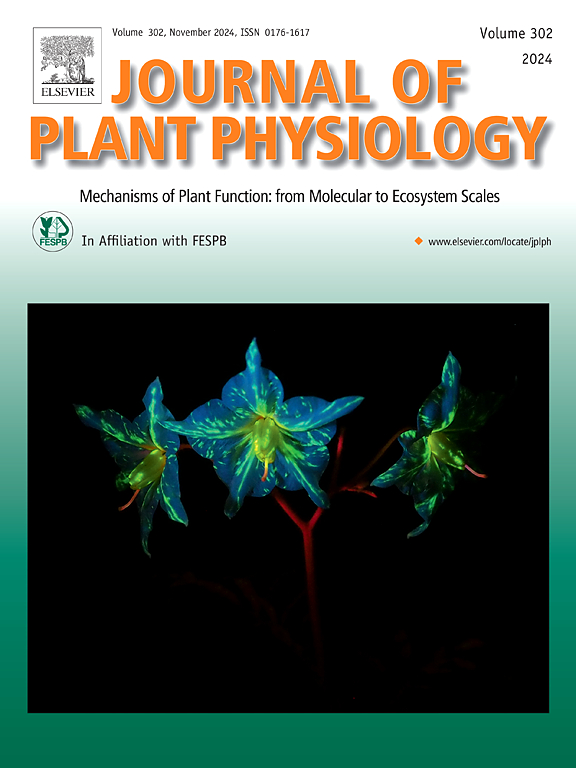软质小麦缺乏邻居感知增加了杂草引起的产量损失
IF 4.1
3区 生物学
Q1 PLANT SCIENCES
引用次数: 0
摘要
杂草是小麦产量的主要制约因素之一,在世界范围内造成重大产量损失。虽然化学防治是克服杂草危害的最常用方法,但由于除草剂的过度使用/误用,杂草对大多数常用除草剂的抗性不断增强,使化学防治的效果受到挑战。与老品种相比,现代小麦品种对杂草的感知能力较差,因此与杂草的竞争能力较弱,需要化学控制以确保足够的产量。在不允许使用化学除草的有机农业中,现代小麦品种对杂草的竞争力较低变得更加严重。本研究的目的是评估两种小麦遗传资源的竞争力,即现代品种Rebelde和从种子库(意大利南部坎帕尼亚地区的种子库)加入的Frassineto。鸢尾是一种由较高株高的老品种演变而来的地方品种。总的来说,我们的目标是评估两个不同的小麦品种在不同的育种时期(老品种与现代品种)、构成株高(高与矮)和邻居感知(敏感与不敏感)方面的不同竞争力。在这里,我们证明了地方品种Frassineto对杂草的存在在茎伸长(+ 46%)、分蘖角增加(+ 27%)以及叶片总叶绿素、叶绿素a/b比(- 29%)和类胡萝卜素(- 71%)方面的响应。这些反应通常与植物对改变的红光的感知有关:远红光,在Rebelde中没有。此外,与Rebelde相比,Frassineto在物候早期表现出更快的生长(分蘖期+ 103%),这是竞争的一个重要组成性状。赤霉素酸能促进植株对光照的纵向生长,在30 μM和100 μM的处理下,Frassineto植株伸长率分别为+ 14.3%和19.6%,而Rebelde植株则没有。同样,参与植物对红色和远红色比例感知的光敏色素相互作用因子(Phytochrome Interactive Factor, PIF)的基因表达在Frassineto中显著上调(+ 46%),而在Rebelde中没有上调。总的来说,这些反应与田间对杂草的抑制能力较高相关,因此产量稳定性更高(+ 198%)。这些结果为开发具有竞争力的小麦品种以适应杂草的农业生态系统提供了重要的见解。本文章由计算机程序翻译,如有差异,请以英文原文为准。
Lack of neighbor perception in soft wheat increases weed-induced yield losses
Weeds are one of the major constraints for wheat productivity, causing significant yield losses worldwide. While chemical control is the most used practice to overcome weed damage, its efficacy is challenged by increasing weed resistance to most used herbicides, which is an expanding phenomenon caused by herbicide overuse/misuse. Modern wheat varieties are less able to perceive the presence of weeds than old varieties and are therefore less competitive against them and require chemical control to ensure adequate yields. The low competitiveness of modern wheat varieties toward weeds becomes even more critical under organic farming, where chemical weeding is not allowed. The goal of this study was to evaluate the competitiveness of two wheat genetic resources, namely Rebelde, that is a modern-day cultivar and Frassineto, an accession from a Seed Bank (Banca Regionale del Germoplasma of the Regione Campania - Southern Italy). Frassineto is a landrace deriving from older varieties with higher plant height. Overall, our goal was to assess the different competitiveness of two contrasting wheat varieties differing in breeding periods (old vs modern), constitutive plant height (tall vs short), and neighbor perception (sensitive vs insensitive). Here we demonstrate that the landrace Frassineto responds to weed presence in terms of stem elongation (+46 %), increased tiller angle (+27 %), and by altering leaf total chlorophyll, chlorophyll a/b ratio (−29 %) and carotenoids (−71 %). These responses, typically linked to plant perception of altered red:far red light, were absent in Rebelde. Moreover, Frassineto showed faster growth at early phenological stages compared to Rebelde (+103 % at the tillering stage), which represents an important constitutive trait of competition. Applications of gibberellic acid, which promotes longitudinal growth in response to light, caused significant stem elongation in Frassineto (+14.3 % at 30 μM and 19.6 % at 100 μM), whereas it did not in Rebelde. Similarly, the gene expression of the Phytochrome Interactive Factor (PIF), involved in plant perception of red:far red ratio, was significantly upregulated in Frassineto (+46 %) but not in Rebelde. Altogether these responses were correlated with higher suppressive ability against weeds in Frassinato vs. Rebelde in the field and consequent higher yield stability (+198 %). These results provide important insights into those traits that should be strengthened for the development of competitive wheat varieties for a weed-resilient agro-ecosystem.
求助全文
通过发布文献求助,成功后即可免费获取论文全文。
去求助
来源期刊

Journal of plant physiology
生物-植物科学
CiteScore
7.20
自引率
4.70%
发文量
196
审稿时长
32 days
期刊介绍:
The Journal of Plant Physiology is a broad-spectrum journal that welcomes high-quality submissions in all major areas of plant physiology, including plant biochemistry, functional biotechnology, computational and synthetic plant biology, growth and development, photosynthesis and respiration, transport and translocation, plant-microbe interactions, biotic and abiotic stress. Studies are welcome at all levels of integration ranging from molecules and cells to organisms and their environments and are expected to use state-of-the-art methodologies. Pure gene expression studies are not within the focus of our journal. To be considered for publication, papers must significantly contribute to the mechanistic understanding of physiological processes, and not be merely descriptive, or confirmatory of previous results. We encourage the submission of papers that explore the physiology of non-model as well as accepted model species and those that bridge basic and applied research. For instance, studies on agricultural plants that show new physiological mechanisms to improve agricultural efficiency are welcome. Studies performed under uncontrolled situations (e.g. field conditions) not providing mechanistic insight will not be considered for publication.
The Journal of Plant Physiology publishes several types of articles: Original Research Articles, Reviews, Perspectives Articles, and Short Communications. Reviews and Perspectives will be solicited by the Editors; unsolicited reviews are also welcome but only from authors with a strong track record in the field of the review. Original research papers comprise the majority of published contributions.
 求助内容:
求助内容: 应助结果提醒方式:
应助结果提醒方式:


